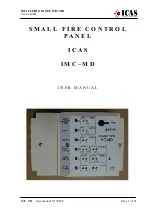
5-1
Chapter 5 Load Control
This section describes the user selectable load control settings (5.1) and the low voltage
load disconnect (LVD) warning indications (5.2). Load information and general cautions
are provided in the remaining sections.
5.1 Load Control Settings
The primary purpose of a low voltage load disconnect function (LVD) is to protect the
system battery from deep discharges that could damage the battery.
In the Load Control mode, the SunStar provides for eight standard LVD settings that are
selected by the DIP switches. These are described in the table below. Custom LVD settings
are possible using two potentiometers (VR2, VR1).
DIP
Switches
12V
LVD
24V
LVD
48V
LVD
Battery
SOC%
12V
LVR
24V
LVR
48V
LVR
off-off-off
11.1 22.2 44.4
8
12.6 25.2 50.4
off-off-on
11.3 22.6 45.2
12 12.8 25.6 51.2
off-on-off
11.5 23.0 46.0
18 13.0 26.0 52.0
off-on-on
11.7 23.4 46.8
23 13.2 26.4 52.8
on-off-off
11.9 23.8 47.6
35 13.4 26.8 53.6
on-off-on
12.1 24.2 48.4
55 13.6 27.2 54.4
on-on-off
12.3 24.6 49.2
75 13.8 27.6 55.2
on-on-on
10.5 21.0 42.0
4
12.0 24.0 48.0
8-on
VR1 Setting
VR2 Setting
Table 5.1 Standard Control Load Programs
The table above describes the standard selectable LVD battery voltages for 12, 24 and 48
volt systems. The LVR values are the load reconnect setpoints. The “Battery SOC %”
provides a general battery state-of-charge figure for each LVD setting. The actual battery
SOC can vary considerably depending on the battery condition, discharge rates, and other
specifics of the system.
5.2 Inductive Loads (Motors)
For dc motors and other inductive loads, it is strongly recommended to install a diode near
the controller. Inductive loads can generate large voltage spikes that might damage the
controller’s lightning protection devices.
The diode should be installed near the controller, and in the orientation
shown in the diagram on the below:
Содержание SS-30C
Страница 1: ......
Страница 29: ...3 5 ...
Страница 30: ...3 6 ...
Страница 50: ...Appendix B ...
Страница 51: ......















































